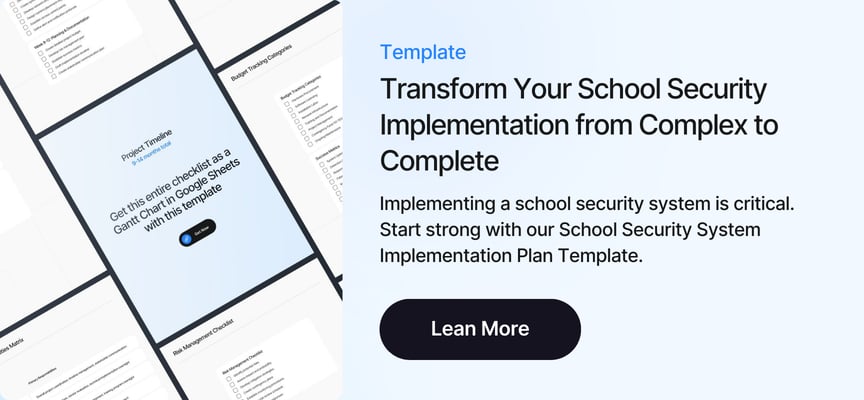The lockdown alarm sounds. Teachers lock doors, students hide under desks. But the shooter is already inside with a clear 8-minute window before police arrive.
Traditional active shooter plans assume detection happens after shots are fired. AI detection changes that assumption completely. What if security knew about the weapon before the first shot? What if lockdown procedures started the moment a gun appeared on camera?
Modern active shooter response integrates AI detection with emergency protocols. Smart systems detect threats in seconds, not minutes. Here's how to build plans that prevent tragedies instead of just responding to them.
Read the School Shooting Prevention Technology Guide.
The Critical Detection Gap
Most active shooter plans follow the same sequence: incident occurs, someone calls 911, police respond, situation resolves. This reactive approach leaves dangerous gaps between threat emergence and response activation.
The Department of Homeland Security reports average active shooter incidents last 12-14 minutes. Police response averages 8-10 minutes from first call. That leaves 2-6 minutes where lives depend entirely on lockdown effectiveness and luck.
FBI analysis of active shooter incidents shows 70% end before police arrive. This means school staff and students handle the most critical moments alone using whatever preparation they've received through periodic drills.
Current detection methods rely on human observation: someone sees the weapon, recognizes the threat, activates emergency protocols. Human detection introduces critical delays. People freeze, hesitate, or fail to immediately recognize weapons in high-stress situations.
Detection Timeline Problems
- Visual confirmation takes 3-8 seconds of direct observation
- Recognition and decision-making add another 5-15 seconds
- Communication to security or administration requires 30-90 seconds
- Emergency protocol activation takes additional 60-120 seconds
These delays compound. By the time lockdown procedures begin, shooters have significant head start and freedom of movement throughout facilities.
AI detection eliminates human recognition delays. Algorithms identify weapons within 1-2 seconds of camera capture. Automated alerts reach security teams instantly. Emergency protocols can activate before anyone realizes threats have emerged.
Visit the full resource center.
AI Integration Points in Emergency Response
Smart active shooter plans integrate AI detection at multiple points throughout emergency response sequences. Each integration point reduces response time and improves outcome potential.
Pre-Incident Detection
AI systems monitor all camera feeds continuously for weapon appearance. The moment firearms appear on campus, automated alerts notify security teams with precise location information. Emergency protocols can activate before shots are fired.
Initial Response Enhancement
Traditional plans depend on human witnesses calling for help. AI detection provides immediate notification regardless of human presence. Security teams receive weapon alerts, location tracking, and real-time movement information without relying on panicked witnesses.
Lockdown Optimization
Smart systems provide precise threat location information enabling targeted lockdown procedures. Instead of campus-wide lockdowns that may trap people near threats, security teams can implement zone-specific protocols based on real-time threat tracking.
Law Enforcement Coordination
AI systems automatically share threat information with responding officers. Police receive location data, movement tracking, and facility layouts before arriving on scene. This situational awareness improves response effectiveness and officer safety.
Recovery Phase Support
Video intelligence provides incident documentation for investigation and family notification. Detailed timelines help identify response improvements and update protocols based on actual incident data.
Real answers from public school administrators who implemented AI security.
Building AI-Enhanced Emergency Protocols
Effective integration requires updating existing emergency plans to incorporate AI detection capabilities. Schools cannot simply add AI systems to current protocols without adapting procedures to utilize new detection speed and accuracy.
Detection Integration Steps
- Connect AI systems directly to emergency notification networks
- Program automated alerts for immediate security team notification
- Establish escalation protocols based on threat types and locations
- Create lockdown procedures utilizing real-time location tracking
- Coordinate with law enforcement for AI data sharing during response
Protocol Modification Requirements
Emergency plans must account for faster detection and response capabilities. Traditional 2-5 minute notification timelines become 10-30 second response requirements. Staff training needs updating to handle AI alerts and real-time threat information.
Communication procedures require modification for AI integration. Instead of relying on human witnesses, emergency protocols activate based on automated threat detection. Staff receive specific location information and real-time updates about threat movement throughout incidents.
VOLT provides seamless integration with existing emergency response protocols. Our platform connects directly with school communication systems, automatically notifying security teams and law enforcement when weapons appear on campus. Real-time location tracking enables precise response coordination.
Training Staff for AI-Enhanced Response
AI integration requires updated training programs that teach staff how to respond to automated alerts and utilize real-time threat information during emergencies.
New Training Components: Staff need instruction on interpreting AI alerts and understanding automated notification systems. Training should cover responding to location-specific information and utilizing real-time tracking data during incidents. Communication protocols require practice with AI-generated situational updates.
Drill Modifications: Emergency drills must incorporate AI detection scenarios. Staff practice responding to automated alerts rather than human observations. Exercises should include location-specific lockdown procedures based on real-time threat tracking information.
Coordination Training: Security teams need instruction on sharing AI-generated information with law enforcement. Training should cover explaining automated detection capabilities to responding officers and utilizing real-time tracking data for tactical coordination.
Traditional active shooter training assumes human detection delays. AI-enhanced training prepares staff for immediate threat notification and rapid response protocols that AI detection enables.
Real-World Implementation Results
Schools integrating AI detection report significant improvements in emergency response capabilities and overall security confidence among staff and students.
Measurable Improvements
Response times decrease from minutes to seconds for threat detection. Location accuracy improves through real-time tracking capabilities. False alarm rates drop through AI validation before human notification. Staff confidence increases with automated backup for human observation.
Operational Benefits
Security teams gain 24/7 monitoring capabilities without additional staffing requirements. Emergency protocols become more precise through location-specific information. Law enforcement response improves through real-time situational awareness. Investigation capabilities enhance through detailed incident documentation.
Schools report that AI integration provides security staff with confidence that threats will be detected immediately regardless of human presence or attention. This assurance enables focus on response coordination rather than detection anxiety.
Cost-Effective Integration Strategy
AI detection integrates with existing camera infrastructure and emergency protocols without requiring complete system replacement. Schools enhance current capabilities rather than rebuilding security programs.
Implementation Approach
Most schools already have camera systems suitable for AI integration. Emergency communication networks can connect with AI detection platforms. Staff training updates existing protocols rather than creating entirely new procedures.
Budget Considerations
AI integration costs significantly less than complete security overhauls while providing dramatic capability improvements. Return on investment comes through enhanced safety outcomes and reduced reliance on additional security staffing.
Deployment Timeline
AI systems typically deploy within 24-48 hours using existing camera infrastructure. Staff training requires 2-4 hours for effective AI alert response. Protocol updates can be implemented within existing emergency planning cycles.
Transform Your Active Shooter Plan with Immediate Detection
Common active shooter plans rely on human detection with built-in delays that cost critical response time. AI detection provides immediate weapon identification and location tracking that enables prevention rather than just response.
VOLT transforms existing security cameras into intelligent threat detection systems that alert security teams the moment weapons appear on campus. Our real-time analysis provides precise location information and continuous tracking throughout incidents, giving your team the situational awareness needed for effective response.
Ready to integrate immediate threat detection into your active shooter plan? Contact VOLT to learn how real-time video intelligence detects weapons instantly, providing your security team with the detection speed and location accuracy needed to prevent tragedies rather than just respond to them. Because when active threats emerge, immediate detection saves lives.






